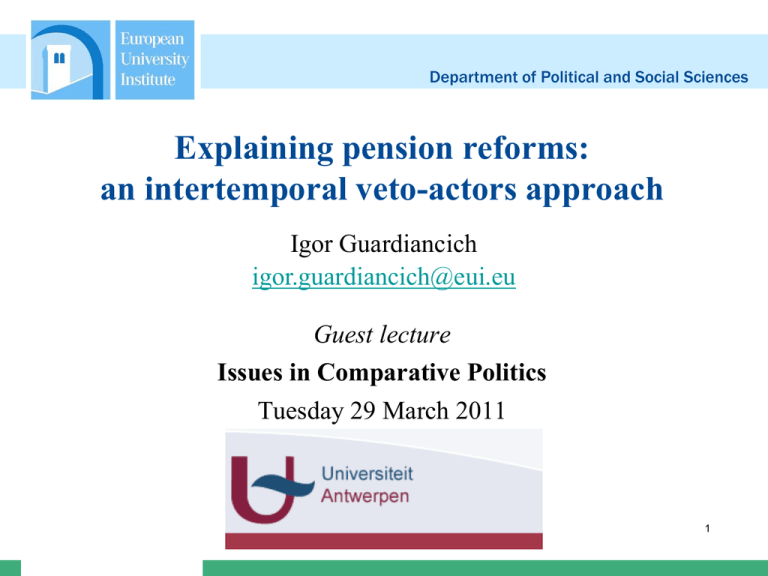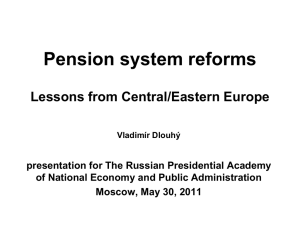EU and supplementary pensions: Instruments for integration
advertisement

Department of Political and Social Sciences Explaining pension reforms: an intertemporal veto-actors approach Igor Guardiancich igor.guardiancich@eui.eu Guest lecture Issues in Comparative Politics Tuesday 29 March 2011 1 Department of Political and Social Sciences SUBSECTION I The rise and fall of Bismarck and Beveridge Nicholas Barr The Welfare State as Piggy Bank: Information, Risk, Uncertainty, and the Role of the State. 2 Department of Political and Social Sciences What Do We Need Pensions For? 3 primary objectives + 1 secondary consumption smoothing over the life-cycle PIGGY BANK OBJECTIVE ii) insurance against various risks DISABILITY, LONGEVITY, DEATH iii) poverty relief ROBIN HOOD OBJECTIVE iv) economic growth INCREASED NATIONAL SAVINGS and LESS LABOUR MARKET DISTORTIONS i) 3 Department of Political and Social Sciences How to organize pensions? 2 main ways i) ii) by storing current production by building a claim on future production This can be financed in two ways: i) funded schemes (401k plans) ii) PAYG schemes (US Social Security) These can pay benefits according to: i) defined-benefit formulae ii) defined-contribution formulae 4 Department of Political and Social Sciences The mythology of pensions AVAILABILITY OF OUTPUT IS THE MAIN THING i) PAYG copes well with inflation ii) PAYG allows pensioners to share in post-retirement economic growth iii) PAYG allows a full pension to be paid immediately iv) FF is vulnerable to unanticipated inflation v) FF does not allow pensioners to benefit from post-retirement economic growth vi) FF take a long time to build up rights for a full pension 5 Department of Political and Social Sciences The well-spring of immortality ARE FUNDED PENSIONS REALLY IMMUNE TO ADVERSE DEMOGRAPHICS? A balanced PAYG requires that sWL=PN. If there is a demographic shock, there are 2 scenarios: Static output – a) pensions are reduced and the demographic burden falls on pensioners; b) contribution rates are raised, imposing the cost on workers. Growing output – In a PAYG average wages increase, pensions do not. The replacement rate declines, but crucially pensioners get the real pensions they were expecting. There is no need for further 6 adjustments. Department of Political and Social Sciences Pension history: Bismarck and Beveridge Bismarck social policies (1889) are based on social insurance, with earnings-related benefits for employees and entitlements based on contribution records, and funded through employer and employee contributions. Beveridgean policies (1942) are characterized by universal provision with entitlement based on residence and in some cases on need, with benefits being flat-rate and financed through general taxation revenue. 7 Department of Political and Social Sciences 8 Department of Political and Social Sciences SUBSECTION II: New Pension Orthodoxy: the case of Central Eastern and Southeastern Europe World Bank Averting the Old Age Crisis USAID Pension Reform in Eastern Europe and Eurasia: Experiences and Lessons Learned 9 Department of Political and Social Sciences New pension orthodoxy Averting the Old Age Crisis - World Bank’s blueprint 13 years after Chile - dual paradigmatic shift: from collective to individual risk bearing and from state to market provision redistribution, coinsurance savings, coinsurance savings, coinsurance objective means-tested, GMI, flat rate individual or occupational schemes individual or occupational schemes form PAYG state-regulated funded funded 1st public mandatory 2nd private mandatory 3° private voluntary financing pillar 10 Department of Political and Social Sciences 11 2000s 1990s 1980s Department of Political and Social Sciences Substitutive Chile (1981) Parallel UK (1986) Mixed Bolivia (1997) Mexico (1997) El Salvador (1998) Kazakhstan (1998) Panama (1999) Peru (1993) Colombia (1994) Nicaragua (2001) Kosovo (2002) Dominica (2003) Nigeria (2005) Lithuania (2004) Argentina (1994) Uruguay (1996) Hungary (1998) Denmark (1999) Poland (1999) Sweden (1999) Bulgaria (2000) Costa Rica (2000) Hong Kong (2000) Latvia (2001) Croatia (2002) Estonia (2002) Russia (2003) India (2004) Slovakia (2005) Macedonia (2006) Romania (2008) 12 Department of Political and Social Sciences Socialist and post-socialist pension systems UNDER SOCIALISM - PAYG financing, but cross-subsidisation of other budget elements - de facto Bismarckian (employment-related, defined-benefit with last or best year formulae), but increasing coverage - low replacement rates, but low retirement age - universalism betrayed by granting special privileges DURING TRANSITION - early retirement, disability - great abnormal pensioner booms - overstretched to the point of breakdown (skyrocketing costs and system dependency ratio) - 3 reform phases: refinancing, retrenchment and restructuring 13 Department of Political and Social Sciences Reforms in Central and Eastern Europe During 1998-2008 more than 10 CESE countries adopted the privatization elements of the ‘new pension orthodoxy’ --Many also individualized their highly redistributive pension systems by adopting Notional Defined Contribution formulae (PL, LV) Defined Benefit point formulae (EE, HR, RO, SK, SR) flat rate benefits (KO) benefits related to automatic stabilizers (FBiH, RS) 14 Department of Political and Social Sciences Objectives and criticism The primary goal of pension systems is to reduce poverty and provide adequate retirement income within a fiscal constraint. --The ‘new pension orthodoxy’ has been criticized from within and without the World Bank. --Despite systemic reforms, the newly instituted retirement schemes fail to fulfil their fundamental objectives. The arguments on the political insulation of multipillar (especially 15 private) schemes were falsified in practice. Department of Political and Social Sciences 5 policy problems - Fiscal sustainability - Social adequacy - Lacking administrative capacity and infrastructure - Insufficient coordination with labour and financial market reforms - Vulnerability of policy to political interference “Without parallel reforms in labor and financial markets, even the best conceptualized pension reform may derail in political and social policy terms. In turn, without a clear reform vision […] the credibility of the reform will be low and, consequently, resistance 16 to reform will be high.” (Holzmann, 2009) Department of Political and Social Sciences SUBSECTION III: Frozen landscapes and immovable objects Paul Pierson The New Politics of the Welfare State Kent Weaver Paths and Forks or Chutes and Ladders?: Negative Feedbacks and Policy Regime Change 17 Department of Political and Social Sciences Why is reform difficult? Misperception of risk 18 Department of Political and Social Sciences Why is reform difficult? Concentrated interests 19 Department of Political and Social Sciences Path-dependence? Path dependence is best described as a process of increasing returns, positive feedback, self-reinforcing feedback – the costs of exit augment at each step we take on a given path increase. Famous examples: QWERTY vs. Dvorak; VHS vs. Betamax Large fixed costs – they lower unit costs and people tend to stick to one option; Learning effects – higher future returns; Coordination effects – when others start using linked infrastructure (software with hardware, complementary property rights); Adaptive expectations – options that fail to win broad acceptance will have 20 drawbacks later on. Department of Political and Social Sciences SUBSECTION IV: Challenging standard veto actors approaches Scartascini, Stein and Tommasi How Do Political Institutions Work? Veto Players, Intertemporal Interactions, and Policy Adaptability Gehlbach and Malesky The Contribution of Veto Players to Economic Reform Guardiancich and Orenstein A Stable State? Political Cycles and Policy Stability in the Implementation of Radical Pension Reforms in Central and Eastern Europe 21 Department of Political and Social Sciences Studying policy stability Stability of public policy is a fundamental variable in the literature on welfare state reforms. Analysts have emphasized the importance of path-dependence, stressing that reforms skid on frozen landscapes and collide with immovable objects. However, path dependence applies far less to Eastern Europe. CEE countries occupy a unique niche in welfare state policy in between the developed West and the developing South. They inherited from socialist times ‘pre-mature welfare states’ which display the fundamental characteristics of Western social policy sophistication, but, are subject to the sort of policy instability and to frequent systemic reversals that are more characteristic of Latin American countries. 22 Department of Political and Social Sciences 1989 1995 2000 2005 2010 NDC Bismarckian Bismarckian Lite Latvia * Poland * Slovenia Czech Hungary Slovakia Estonia* Lithuania* Universal Mixed Residual Asterisk indicates that a country has added a small mandatory or quasi-mandatory defined contribution individual account tier. Croatia* Kosovo* 23 Department of Political and Social Sciences Gross Replacement Rates 24 Department of Political and Social Sciences Standard veto actors Proposition 1: A more decisive polity must necessarily be less resolute (Haggard and Mc Cubbins). Proposition 2: As the effective number of vetoes increases, the polity becomes more resolute and less decisive (Haggard and Mc Cubbins). Or equivalently: Many veto players make significant policy changes difficult or impossible (Tsebelis). 25 Department of Political and Social Sciences 26 Department of Political and Social Sciences Intertemporal veto actors I Proposition 1: A more decisive polity not necessarily must be less resolute. There are some forces (of different equilibria in repeated-interaction contexts) leading to a positive association between decisiveness and resoluteness (adaptability and stability). Proposition 2: Many veto players do not necessarily make significant policy changes difficult or impossible. There are some channels through which more veto players increase policy adaptability. 27 Department of Political and Social Sciences Intertemporal veto actors II The literature on intertemporal cooperation has focussed only on: i) the number of veto players (Scartascini, Stein and Tommasi, 2008; Gehlbach and Malesky, 2010); ii) the probability that the policy distance a future veto player will be great/small (Frye, 2010). This paper combines the two. 28 Department of Political and Social Sciences Polarization and other indicators Polarization Freedom House Index during 1990-2008 reforms Change in government Policy after pension reform reversals legislation Croatia 0,74 PF (4/4) before 2000 F (2/3) after 2000, declining Yes Yes Hungary 0,79 F (1/2) Yes Yes Poland 0,21 F (1/2) Yes No Slovenia 0,21 F (1/2) No No Sources: Armigeon and Careja (2008), Frye (2010), Freedom House, own calculations. 29 Croatia Department of Political and Social Sciences Croatia is a relatively extreme case of reform under majoritarian institutions and high polarization. Croatia went through two periods in its post-communist political development: the first, the semi-presidential rule of Franjo Tuđman and his political party, the Croatian Democratic Union (HDZ), and the second, a period of rapid democratization under prodemocratic, pro-EU governments starting in 2000. Pension reform in Croatia took place under the first regime, while implementation took place under the second. The majoritarian institutional framework facilitated radical reform, but continuing political polarization intensified instability in implementation. 30 Croatia Department of Political and Social Sciences 31 Hungary Department of Political and Social Sciences Hungary has one of the least constrained executives in Central, Eastern and Southeastern Europe. After the ascendancy of the right party, Fidesz, in 1998, its twoparty system became so polarized that one analyst (Bozóki 2008: 224) writes that the country is in a civil cold war that violently erupts during each election. Political business and policy cycles are consequently extreme. Similar to Croatia, the Hungarian case shows how policies adopted by a small number of veto players are vulnerable to later policy instability. 32 Hungary Electoral cycles and coalition governments Pressures and policymaking Department of Political and Social Sciences Reform outcome Disproportionalities/ reversals Structural: parametric reforms in public DB pillar, mandatory FDC pillar Concessions to MSzOSz (political appointments and control of the pension Insurance Fund) and the financial service lo b b y Mandatory funded pillar rendered voluntary Opt-outs from the mandatory pillar allowed, contribution rates frozen, MSzOSz eliminated from the Pension Insurance Fund Oversized twoparty centre-left, liberal coalition (Horn I) 1997 Opposition parties (Fidesz, MDF), civil society at large excluded 19982002 Two-party centreright coalition (Orbán I) 1988 and 2001 Opposition parties (MSzP, SzDSz), trade unions (MSzOSz) and financial service lobby excluded 20022006 Two-party centreleft, liberal coalition (Medgyessy I, Gyurcsány I) 2002-2005 Mandatory funded pillar returned to Election promise to raise benefits and reverse reforms original status Ad hoc increases in pension levels, introduction of the thirteenth pension 20062010 Two-party centreleft, liberal coalition (Gyurcsány II, Bajnai I) 2006-2007 and 2009 Crisis-related pressures on debt and deficit, EU and International Organizations dictating the pace of reforms No major changes Thirteenth pension eliminated, price indexation introduced, retirement age stepwise increased 2010now Oversized twoparty centre-right coalition (Orbán II) 2010 Unilateral Mandatory funded pillar rendered voluntary All insured encouraged to switch back, withdrawal of any 33 government guarantee 19941998 Poland Department of Political and Social Sciences Poland stands in stark contrast to cases of divisive policy-making and limited bargaining, such as Croatia or Hungary. Poland has far more inclusive political institutions, a less polarized party system with numerous groups represented, and a high level of civil society involvement in politics. Poland is often compared to Hungary, yet its affinities with Slovenia are more marked. The two countries’ executives were constrained in their choices and legislated successfully only through inclusive policymaking. 34 Poland Department of Political and Social Sciences 35 Slovenia Department of Political and Social Sciences Among the cases analyzed in this paper, neo-corporatist Slovenia is the most consensual democracy. Its political-institutional structure generates numerous veto points, due to fragmented parties, proportional representation, and the strongest labor movement in Central, Eastern and Southeastern Europe. Hence, Slovenian executives are continuously reminded that divisive policymaking is rarely a feasible strategy, especially when legislating complex socioeconomic policies 36 Slovenia Department of Political and Social Sciences 37 Department of Political and Social Sciences Thank you very much 38








